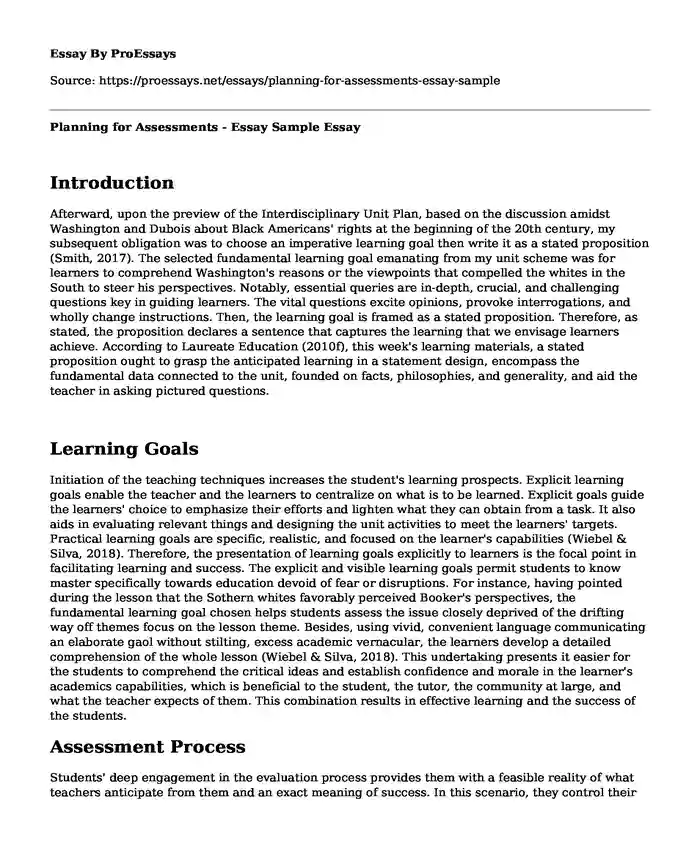Introduction
Afterward, upon the preview of the Interdisciplinary Unit Plan, based on the discussion amidst Washington and Dubois about Black Americans' rights at the beginning of the 20th century, my subsequent obligation was to choose an imperative learning goal then write it as a stated proposition (Smith, 2017). The selected fundamental learning goal emanating from my unit scheme was for learners to comprehend Washington's reasons or the viewpoints that compelled the whites in the South to steer his perspectives. Notably, essential queries are in-depth, crucial, and challenging questions key in guiding learners. The vital questions excite opinions, provoke interrogations, and wholly change instructions. Then, the learning goal is framed as a stated proposition. Therefore, as stated, the proposition declares a sentence that captures the learning that we envisage learners achieve. According to Laureate Education (2010f), this week's learning materials, a stated proposition ought to grasp the anticipated learning in a statement design, encompass the fundamental data connected to the unit, founded on facts, philosophies, and generality, and aid the teacher in asking pictured questions.
Learning Goals
Initiation of the teaching techniques increases the student's learning prospects. Explicit learning goals enable the teacher and the learners to centralize on what is to be learned. Explicit goals guide the learners' choice to emphasize their efforts and lighten what they can obtain from a task. It also aids in evaluating relevant things and designing the unit activities to meet the learners' targets. Practical learning goals are specific, realistic, and focused on the learner's capabilities (Wiebel & Silva, 2018). Therefore, the presentation of learning goals explicitly to learners is the focal point in facilitating learning and success. The explicit and visible learning goals permit students to know master specifically towards education devoid of fear or disruptions. For instance, having pointed during the lesson that the Sothern whites favorably perceived Booker's perspectives, the fundamental learning goal chosen helps students assess the issue closely deprived of the drifting way off themes focus on the lesson theme. Besides, using vivid, convenient language communicating an elaborate gaol without stilting, excess academic vernacular, the learners develop a detailed comprehension of the whole lesson (Wiebel & Silva, 2018). This undertaking presents it easier for the students to comprehend the critical ideas and establish confidence and morale in the learner's academics capabilities, which is beneficial to the student, the tutor, the community at large, and what the teacher expects of them. This combination results in effective learning and the success of the students.
Assessment Process
Students' deep engagement in the evaluation process provides them with a feasible reality of what teachers anticipate from them and an exact meaning of success. In this scenario, they control their achievements, which forms the importance (Laureate Education, 2020f). Presenting the learners with more substantial ownership powers in the learning activities marks them the experiences and poses it more authentic. Direct engagement of learners in the evaluation process provides the learners with not only participation but also choices. The learners are the critical decision-makers in their education, and it is imperative to engage them to participate during the assessments. The assessments may intimidate most students. Therefore, transparency in the learning outcomes before an assessment can ensure the learners feel the impetus to perform well (Involving Students, 2018). The assessments may take the form of formative, providing information to learners and tutors that advance teaching and knowledge acquisitions (Reeves, 2007). This evaluation is mostly informal. On the other hand, summative assessment encompasses the cumulative assessments, which often occur towards the end of the unit coverage, focusing on capturing knowledge the learner has acquired or the capacity of learning and analyzing the performance based on specific standards.
Conclusion
Finally, the best explicit learning is founded on the conceptual connections to integrate novel information to data already stored in the memory. Hence, it is vital to disintegrate the data into elements developing the known to the unknown, which aids in the assessments to evaluate the mastery of the concert the students have learned.
References
Reeves, D. B. (ed). (2007). Ahead of the curve: The power of assessment to transform teaching and learning. Bloomington, IN Solution Tree Press.
Laureate Education. (Producer). (2010f). Assessment for student learning: Paper-and-pencil assessments. [Video file]. Baltimore, MD
Smith, S. (2017). DuBois vs. Washington: Who Was Right? Unpublished manuscript, Walden University.
Wiebel, J. C., & Silva, V. T. (2018). Why we say it like that: Making rhetorical practices explicit for students in disciplinary and interdisciplinary courses. College Teaching, 66(1), 24-30.
Cite this page
Planning for Assessments - Essay Sample. (2024, Jan 11). Retrieved from https://proessays.net/essays/planning-for-assessments-essay-sample
If you are the original author of this essay and no longer wish to have it published on the ProEssays website, please click below to request its removal:
- Making Successful College Students
- Should We Have Same-Sex Schools: Annotated Bibliography
- Essay Sample on Child Labor
- Essay Sample on Gaining Life Skills Through College: A Positive Experience
- A Childhood Dream Fulfilled: Essay Sample on My Journey to Becoming a Nurse
- Essay Example on Effective Literacy Stations: Vital for Early Childhood Development
- Essay on No Pay, No Support: The Reality of Unpaid Internships







